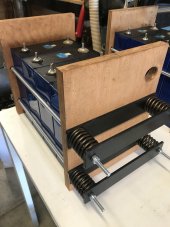My first post on the forum, so firstly a big thanks to everyone for the advice and knowledge shared. I have learned a lot, I think – what follows may prove/disprove that!
My build is at feasibility stage, but compression is an important consideration for me as space constraints require my 1P16S battery to be configured 1 x 16 cells in a single row. From the feedback on this forum, I therefore need to manage 8mm expansion across my battery pack through the charging cycle (0.5mm per cell) and maintain specified compression.
I am planning 4 bolts for compression, with springs at either end (so 8 in total), allowing each spring to manage 4mm of expansion. I would also plan to apply 300kgf at 30-40% SOC specified in the latest EVE 280K specification (attached - for which thanks, Amy Wan).
With c 150mm space each end of the pack to limit free length of each spring and prioritising as low change in load/mm as possible, 2 springs off the Lee Spring website really fit my requirements (LHL 1250A 10 & LHL 1000AB 12). Both springs have change in load of c 1.6kg/mm, so that a 4mm change per spring would increase individual spring load by c 6.5kg or 26kg across the pack. Compared to the 300kgf, this is a <10% change in compression force. This was confirmed in conversation with a technician from Lee Spring.
In psi terms, this equates to an increase from 12 to 13 psi if cells expand the full 8mm across the pack. Well below the critical level of 17 psi referenced elsewhere in this thread. They would really have to blow to get close to 17…
One other limiting factor highlighted by their technician: if the springs are deflected 80% or more from their resting state, this compromises their future performance. The 2 springs selected above under my assumptions only reach 70% deflection when 8mm cell expansion occurs, so some headroom there, too.
This spring configuration fits my purpose and space constraints, and appears to keep the cells very close to 12 psi on average - if my calcs are correct! This may be of use to other forum members.
My build is at feasibility stage, but compression is an important consideration for me as space constraints require my 1P16S battery to be configured 1 x 16 cells in a single row. From the feedback on this forum, I therefore need to manage 8mm expansion across my battery pack through the charging cycle (0.5mm per cell) and maintain specified compression.
I am planning 4 bolts for compression, with springs at either end (so 8 in total), allowing each spring to manage 4mm of expansion. I would also plan to apply 300kgf at 30-40% SOC specified in the latest EVE 280K specification (attached - for which thanks, Amy Wan).
With c 150mm space each end of the pack to limit free length of each spring and prioritising as low change in load/mm as possible, 2 springs off the Lee Spring website really fit my requirements (LHL 1250A 10 & LHL 1000AB 12). Both springs have change in load of c 1.6kg/mm, so that a 4mm change per spring would increase individual spring load by c 6.5kg or 26kg across the pack. Compared to the 300kgf, this is a <10% change in compression force. This was confirmed in conversation with a technician from Lee Spring.
In psi terms, this equates to an increase from 12 to 13 psi if cells expand the full 8mm across the pack. Well below the critical level of 17 psi referenced elsewhere in this thread. They would really have to blow to get close to 17…
One other limiting factor highlighted by their technician: if the springs are deflected 80% or more from their resting state, this compromises their future performance. The 2 springs selected above under my assumptions only reach 70% deflection when 8mm cell expansion occurs, so some headroom there, too.
This spring configuration fits my purpose and space constraints, and appears to keep the cells very close to 12 psi on average - if my calcs are correct! This may be of use to other forum members.




